-
Friends, our 2nd Amendment rights are always under attack and the NRA has been a constant for decades in helping fight that fight.
We have partnered with the NRA to offer you a discount on membership and Muzzleloading Forum gets a small percentage too of each membership, so you are supporting both the NRA and us.
Use this link to sign up please; https://membership.nra.org/recruiters/join/XR045103
You are using an out of date browser. It may not display this or other websites correctly.
You should upgrade or use an alternative browser.
You should upgrade or use an alternative browser.
I Quit While I Was Ahead.
- Thread starter Herb
- Start date

Help Support Muzzleloading Forum:
This site may earn a commission from merchant affiliate
links, including eBay, Amazon, and others.
You are correct tg so I will ask that references to modern cartridges and their use is to be avoided.
It would also be a good idea for the comments to get back on topic (which was sighting in and determining a good load for a .58 caliber Hawken).
It would also be a good idea for the comments to get back on topic (which was sighting in and determining a good load for a .58 caliber Hawken).
Herb
54 Cal.
- Joined
- Mar 19, 2004
- Messages
- 1,954
- Reaction score
- 456
OK, Zonie. I got busy with other things. The references to shooting big game do apply to muzzleloaders, except we are not using scope sights and are not shooting at long ranges. That is, bullet placement and avoiding big bones. There is not much available written about roundball bullet behavior in game animals. In Lyman's "Blackpowder Handbook", volume I, an article by Val Forget is about hunting in Africa with .58 caliber Hawken-style rifles. These were caplock, 26 inch barreled, 1-in-60 rifling twist, 9.5 pound rifles using musket caps. Their loads? Up to 200 grains of 3F black powder, but they settled on 180 grains of 3FG with 610 grain Minie balls. This was for optimum results, "the entire charge was consumed within the barrel." They were able to obtain consistent 4.5 inch groups at 100 yards. Killed a hippo, an elephant, wildebeast and sable, zebra and a cape buffalo. But few of us will ever do this.
The same book has an article by Dr. Gary White, who then owned the Green River Rifle Works, later he had White Rifle Systems. He took a .54 Leman Indian Trade Rifle on an Alaska hunt. His load was the .526 roundball and 150 grains of C&H black powder for 1860 fps, sighted at 100 yards. He stalked to within 50 yards of a Dall ram and shot it in the neck. He wrote: 'To my immense surprise he jumped up and ran off....(he chased him and reloaded)..I shot the ram at 150 yards, hitting him in the lungs for a quick kill.'
I built a Leman Trade rifle in the GRRW shop in 1978 and once shot a mule deer in the neck with a .530 roundball and 120 grains of Goes 2F at about 1820 fps, at 90 yards. Will tell that story later, but that neck shot failed, too.
The same book has an article by Dr. Gary White, who then owned the Green River Rifle Works, later he had White Rifle Systems. He took a .54 Leman Indian Trade Rifle on an Alaska hunt. His load was the .526 roundball and 150 grains of C&H black powder for 1860 fps, sighted at 100 yards. He stalked to within 50 yards of a Dall ram and shot it in the neck. He wrote: 'To my immense surprise he jumped up and ran off....(he chased him and reloaded)..I shot the ram at 150 yards, hitting him in the lungs for a quick kill.'
I built a Leman Trade rifle in the GRRW shop in 1978 and once shot a mule deer in the neck with a .530 roundball and 120 grains of Goes 2F at about 1820 fps, at 90 yards. Will tell that story later, but that neck shot failed, too.
Herb
54 Cal.
- Joined
- Mar 19, 2004
- Messages
- 1,954
- Reaction score
- 456
It has rained and snowed, so haven't gotten to my range since October 5th. Then I shot my 120 grain load with .570 balls and .0205 Levi material. Had to literally hammer the short starter to start the ball. Once down about 6 inches, the steel range rod seats it with pushing. Also used one .019 patch of unknown material, had to hammer that one, too. Four shots averaged 1559 fps, radio interference didn't allow the chronograph to read the fifth shot. Rain coming, so I had to stop.
Lyman's first edition lists loads with .562 roundballs and G-O FFg black powder up to 180 grains at 1737 fps. We no longer have this powder, our modern Goex is hotter. But they used .015 patch material with Crisco for lube. They dry-brushed with a sturdy copper brush between shots and cleaned after each five-shot string.
Lyman's second edition, the .58 roundball loads were fired with .570 balls and Ox-Yoke .010 pre-lubed patches. They went up to 140 grains of Goex 2F at 1773 fps and 9100 psi pressure. They cleaned after each five shots but do not say that they brushed after each shot. They also used a lot of conical bullets. Heaviest was a 577-grain cast bullet with 140 grains of Goex 2F at 1396 fps and 13,200 psi, in a 1 in 48" twist barrel, same as the roundball loads.
Hodgdon's "Basic Reloading Manual" shows the use of .020 OxYoke patch for roundballs and Pyrodex RS and Select and Triple 7 powders. They do not list loads for .58 caliber, but they don't for .40 caliber, either.
So far, my best results are the .562 ball and the red cotton duck (.022) cloth patches and no over powder wad, or the .570 ball, .015 OxYoke and cotton ball OPWs. If I can find my .020 bulk OxYoke patching, I want to try it, too.
Lyman's first edition lists loads with .562 roundballs and G-O FFg black powder up to 180 grains at 1737 fps. We no longer have this powder, our modern Goex is hotter. But they used .015 patch material with Crisco for lube. They dry-brushed with a sturdy copper brush between shots and cleaned after each five-shot string.
Lyman's second edition, the .58 roundball loads were fired with .570 balls and Ox-Yoke .010 pre-lubed patches. They went up to 140 grains of Goex 2F at 1773 fps and 9100 psi pressure. They cleaned after each five shots but do not say that they brushed after each shot. They also used a lot of conical bullets. Heaviest was a 577-grain cast bullet with 140 grains of Goex 2F at 1396 fps and 13,200 psi, in a 1 in 48" twist barrel, same as the roundball loads.
Hodgdon's "Basic Reloading Manual" shows the use of .020 OxYoke patch for roundballs and Pyrodex RS and Select and Triple 7 powders. They do not list loads for .58 caliber, but they don't for .40 caliber, either.
So far, my best results are the .562 ball and the red cotton duck (.022) cloth patches and no over powder wad, or the .570 ball, .015 OxYoke and cotton ball OPWs. If I can find my .020 bulk OxYoke patching, I want to try it, too.
wahkahchimaol.com
45 Cal.
- Joined
- May 17, 2009
- Messages
- 595
- Reaction score
- 15
As a guide on a ranch in California, I made a few of those rump shots on animals which other hunters had wounded. I did an examination on the animals every time a hunter brought one down...or failed to bring one down, resulting in my involvement. My thought is that I would take a rump shot only on a previously wounded animal which was otherwise going to escape to go die slowly in the brush. Otherwise it's way too messy if you intend to eat the animal, and way too uncertain. Hunters who took that rump shot on a nonwounded animal often ended up creating a very sad situation with a terminally wounded animal which crawled off to die. At the beginning of my years guiding I was carrying a .308. By the time 20 years had passed I was using a .300 Magnum or a .45-70 to be sure I could clean up someone else's mess. So now I don't want to be the one making the mess.
Herb
54 Cal.
- Joined
- Mar 19, 2004
- Messages
- 1,954
- Reaction score
- 456
I ordered a half yard of .020 OxYoke patching from Track, along with a Lee double cavity .562 mold, don't know who I loaned my single .562 mold to, but probably never will see it again. I polished the crown of the muzzle more and it helped. Today shot .570 balls with some old .019 pillow ticking and 120 grains of Goex 2F at 100 yards and it held together. I just miked PT at WalMart, think it was .014, and I even have some new PT from a Hutterite (?) farm store in Iowa that is about .008. I have some linen, about .019, think I got it in Idaho Falls, maybe a Joann fabric store. It looks like fine burlap, not a tight weave, didn't expect much of it, but it worked. No OverPowderWads today.
So I tried 140 grains of Goex 2F with .570 balls and then .562 balls, equal accuracy and velocity. This linen is great. Easy to load, two whomps with the heel of my hand on the short starter with .570 balls, only one with the .562. Then they push down the bore easily. The linen holds enough "lube" that the bore is clean clear down to the bullet seat area. I shot the last 15 shots with no wiping between shots nor cleaning after 5-shot groups.
Joann.com lists linen on sale today, regular $14.99 now $8.99, but it looks different from what I have. See photo below. Also says "many colors". Does anyone know if this linen is thick, say about .019", and does it come in red? If it did, I'd order a couple of yards and my patch search would be over!
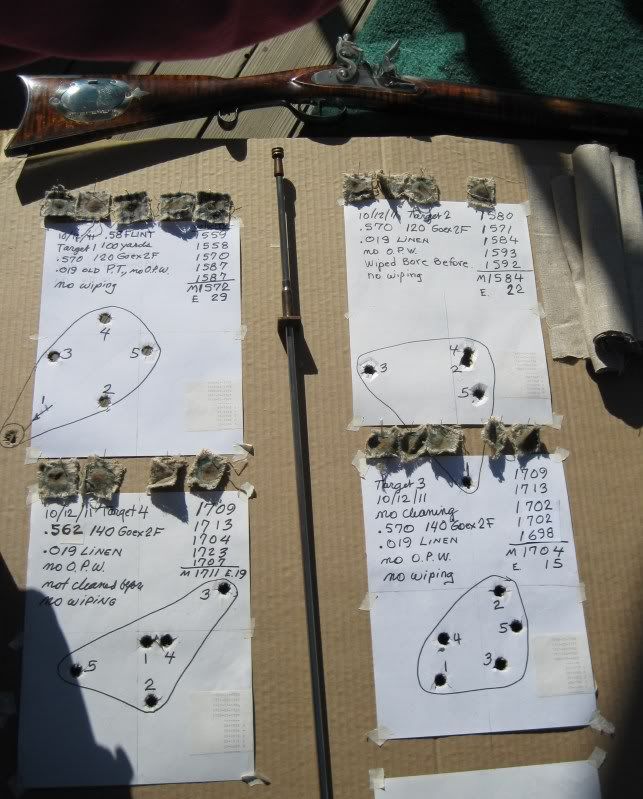
So I tried 140 grains of Goex 2F with .570 balls and then .562 balls, equal accuracy and velocity. This linen is great. Easy to load, two whomps with the heel of my hand on the short starter with .570 balls, only one with the .562. Then they push down the bore easily. The linen holds enough "lube" that the bore is clean clear down to the bullet seat area. I shot the last 15 shots with no wiping between shots nor cleaning after 5-shot groups.
Joann.com lists linen on sale today, regular $14.99 now $8.99, but it looks different from what I have. See photo below. Also says "many colors". Does anyone know if this linen is thick, say about .019", and does it come in red? If it did, I'd order a couple of yards and my patch search would be over!

Last edited by a moderator:
Herb
54 Cal.
- Joined
- Mar 19, 2004
- Messages
- 1,954
- Reaction score
- 456
I finally found my .020 OxYoke patching. It was in containers labeled ".015 OxYoke", I'd precut it to round patches. I had been shooting it in these tests, and it mikes .015. How I know is, today I got my .020 dry bulk fabric Eastern Maine Shooting Supplies, Inc., order number EMSS0200, from Track of the Wolf, and that stuff mikes .015. This is the old OxYoke business. I have a similar package of EMSS .015, and it mikes about .012. So I E-mailed EMSS Inc. to ask them about this, but they haven't had time to answer.
Also phoned JoAnn fabrics in Idaho Falls, and the linen on sale on the web site is the .019 material I am using and like so well. Web site says "many colors", but they show only natural (tan), white and black. Idaho Falls had only purple and blue, but I don't think I want that for patches. Then I realized that since this linen works so well, I don't have to find each patch to see if it tore! JoAnn fabrics also has the duck canvas in colors, but it is $9.99 a yard on sale compared to $8.99 for the linen. I have enough linen on hand to do me for my .58. This linen is the best patch material I have found.
Also phoned JoAnn fabrics in Idaho Falls, and the linen on sale on the web site is the .019 material I am using and like so well. Web site says "many colors", but they show only natural (tan), white and black. Idaho Falls had only purple and blue, but I don't think I want that for patches. Then I realized that since this linen works so well, I don't have to find each patch to see if it tore! JoAnn fabrics also has the duck canvas in colors, but it is $9.99 a yard on sale compared to $8.99 for the linen. I have enough linen on hand to do me for my .58. This linen is the best patch material I have found.
Herb
54 Cal.
- Joined
- Mar 19, 2004
- Messages
- 1,954
- Reaction score
- 456
Went out today and tried the ".020" Ox Yoke patching, which really mikes about .015, just to confirm what I already knew. My first target was with 120 grains of Goex 2F, .570 balls and the .019 linen. Only needed three shots to establish a base line. Then I used the linen with 120 grains of Swiss 1 1/2 for Target II, and it held together. This heavy a load of Swiss powder will foul the bore for the first six inches or so, but I was able to *** the ball down with my range rod. If I used this load in target shooting, I'd have to wipe between shots.
Target III, on the left, was with 120 grains of Triple 7 2F and 5 grains of Goex 2F booster charge, same for prime. I used the ".020" Ox Yoke patch, which Hodgdon used for their max load of 120 grains in a .54 with a roundball, and of course the patch blew, as I knew it would. Second shot was with this material but with a cotton ball for an OverPowderWad. Patch was OK. Third shot was with the .019 linen but no OPW, it held together. Last two shots 1976 and 1988 fps, group was about nine inches above point of aim.
Target IV was with 100 grains of T7 2F and the .019 linen, but the first patch blew so I used the cotton ball OPW for the next two shots.
Target V I went down to 90 grains of T7 2F and the 5 grain Goex 2F boost, .019 linen patches and no OPW. Patches held together except No. 4 blew. So this seems about the maximum with the .019 linen, unless a strong OPW is used. I have no further interest in testing the Triple 7 powder, now that I know that the linen works better than any other patching material I have.
So my elk load will be 140 grains of Goex 2F, spare loads measured into tubes for fast loading. Will cast some .562 balls soon and use those.
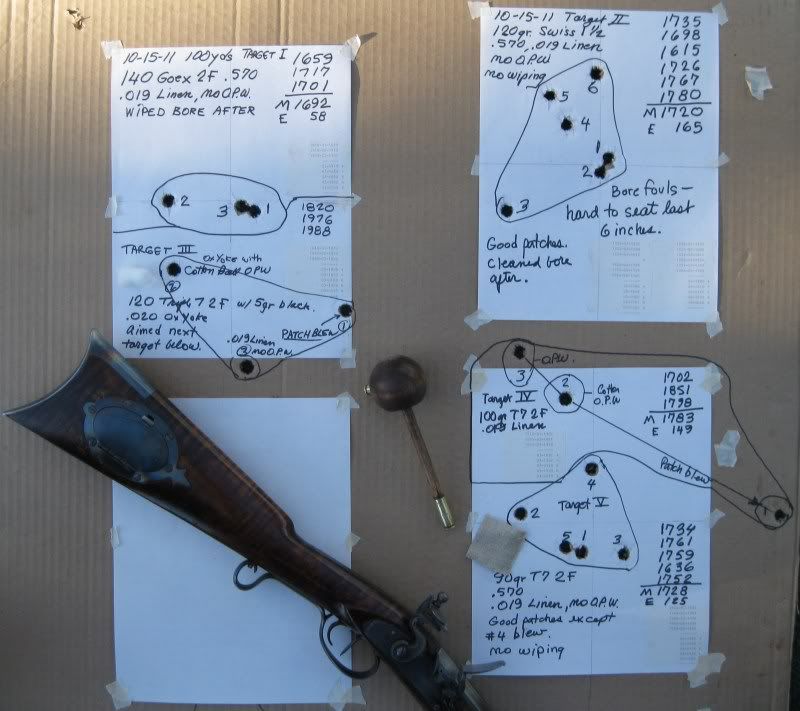
Target III, on the left, was with 120 grains of Triple 7 2F and 5 grains of Goex 2F booster charge, same for prime. I used the ".020" Ox Yoke patch, which Hodgdon used for their max load of 120 grains in a .54 with a roundball, and of course the patch blew, as I knew it would. Second shot was with this material but with a cotton ball for an OverPowderWad. Patch was OK. Third shot was with the .019 linen but no OPW, it held together. Last two shots 1976 and 1988 fps, group was about nine inches above point of aim.
Target IV was with 100 grains of T7 2F and the .019 linen, but the first patch blew so I used the cotton ball OPW for the next two shots.
Target V I went down to 90 grains of T7 2F and the 5 grain Goex 2F boost, .019 linen patches and no OPW. Patches held together except No. 4 blew. So this seems about the maximum with the .019 linen, unless a strong OPW is used. I have no further interest in testing the Triple 7 powder, now that I know that the linen works better than any other patching material I have.
So my elk load will be 140 grains of Goex 2F, spare loads measured into tubes for fast loading. Will cast some .562 balls soon and use those.

Herb
54 Cal.
- Joined
- Mar 19, 2004
- Messages
- 1,954
- Reaction score
- 456
I called JoAnn Fabrics to ask about their linen. They could not tell me how thick it is, but said it weighed .625 pounds per yard. They could not tell me how much pillow ticking weighs, as a comparison. So I gambled and ordered two yards at about $7.25 per yard. Turns out to be only about .012 thick, whereas my earlier lot is .019 thick. Oh well, I can offer it as a blanket prize. It does not stand heavy charges, but is OK with an overpowder wad, though I'll use my .019 linen for the hunt.
The ".020" OxYoke from Track really measures .015, so I E-mailed Eastern Maine Shooting Sports, who make this, to ask about it. They sent me a hand-selected .020 package. Turns out to be about .018 to .019, but works good. They have a good web site and a good catalog.
So I tested this stuff with 80 and 140 grains of Goex 2F while Bob sighted in his .50 caliber modern ML, using two, 50 grain Pyrodex RS pellets and a sabot pistol bullet. I had never seen one of these fired and it was enlightening. First, the battery was dead in the no-power scope with the red dot. He changed that and loaded, telling me about the time he shot his ramrod. First shot at 100 yards was 8 inches out at 8 o'clock, so he changed the scope. Second shot was that far out at 2 o'clock, so he went back. Third shot was in the bull. Fourth shot hit about 5 feet northeast of the bull, I figured he'd ****** the rifle on the sandbags. Fourth load, he dropped two pellets in, short started the pistol bullet, and couldn't find his ramrod. He'd shot it again! So I loaned him my wooden ramrod and he seated the ball. He didn't measure the seated depth and I didn't pay any attention. I think he hit the target. He quit, so then I loaded up 80 grains and the new .012 linen and shot at a used 100 yard target. Hit 3/4 inch left of center. He managed to conceal his amazement that this "antique" rifle with open sights could shoot like that. So I used 140 grains and my .019 linen at shot at 200 yards. Four inches over dead center. Next, hit a rock at about 150 yards, dead center. So we quit and went to WalMart for a new ramrod, about $22. Next day he said he cleaned his rifle and found a six-inch "sliver" of the rod still in the bore! How he was able to seat those pellets past that, and then the bullet, I'll never know. I figured he'd ruined the barrel, but he went out and shot it and it works OK. So much for modern technology!

Today I went back to shoot these patches some more. Shot the .020 OxYoke three times at a 200 yard target with 140 grains. Used the top of the front sight at the top of the rear sight for zero.
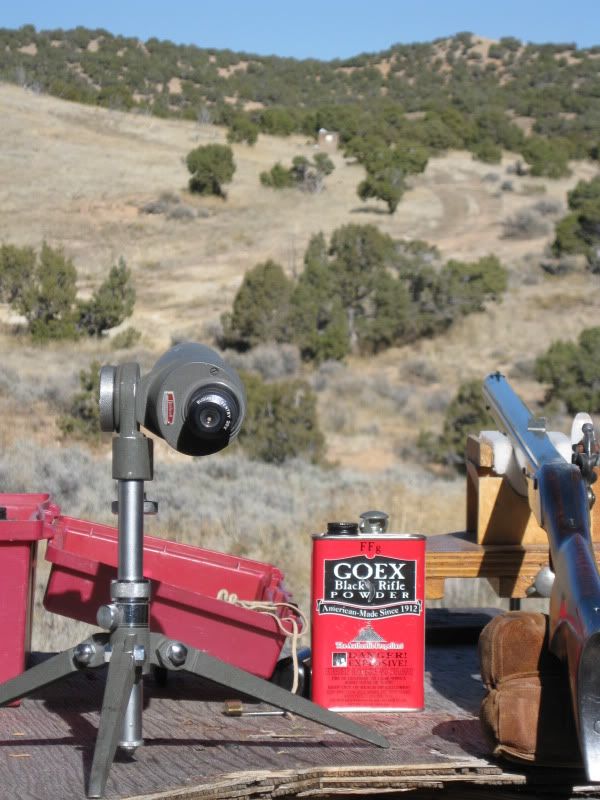
The paper is 10 by 12 inches, and here are my three shots. The front sight covers about 14 inches width and the "horns" of the hole spread about 4 feet.

Bob and I scouted our hunting area and saw one spike bull at about 70 yards. On the way home we drove past Simplot, a phosphate mine, and saw about 150 elk on the reclaimed mined area. Only one big bull and 6 or 8 spikes.
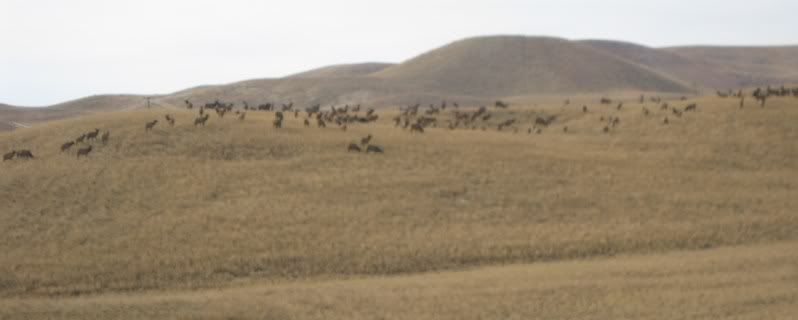 Well, I think we are ready for our hunt.
Well, I think we are ready for our hunt.
The ".020" OxYoke from Track really measures .015, so I E-mailed Eastern Maine Shooting Sports, who make this, to ask about it. They sent me a hand-selected .020 package. Turns out to be about .018 to .019, but works good. They have a good web site and a good catalog.
So I tested this stuff with 80 and 140 grains of Goex 2F while Bob sighted in his .50 caliber modern ML, using two, 50 grain Pyrodex RS pellets and a sabot pistol bullet. I had never seen one of these fired and it was enlightening. First, the battery was dead in the no-power scope with the red dot. He changed that and loaded, telling me about the time he shot his ramrod. First shot at 100 yards was 8 inches out at 8 o'clock, so he changed the scope. Second shot was that far out at 2 o'clock, so he went back. Third shot was in the bull. Fourth shot hit about 5 feet northeast of the bull, I figured he'd ****** the rifle on the sandbags. Fourth load, he dropped two pellets in, short started the pistol bullet, and couldn't find his ramrod. He'd shot it again! So I loaned him my wooden ramrod and he seated the ball. He didn't measure the seated depth and I didn't pay any attention. I think he hit the target. He quit, so then I loaded up 80 grains and the new .012 linen and shot at a used 100 yard target. Hit 3/4 inch left of center. He managed to conceal his amazement that this "antique" rifle with open sights could shoot like that. So I used 140 grains and my .019 linen at shot at 200 yards. Four inches over dead center. Next, hit a rock at about 150 yards, dead center. So we quit and went to WalMart for a new ramrod, about $22. Next day he said he cleaned his rifle and found a six-inch "sliver" of the rod still in the bore! How he was able to seat those pellets past that, and then the bullet, I'll never know. I figured he'd ruined the barrel, but he went out and shot it and it works OK. So much for modern technology!

Today I went back to shoot these patches some more. Shot the .020 OxYoke three times at a 200 yard target with 140 grains. Used the top of the front sight at the top of the rear sight for zero.

The paper is 10 by 12 inches, and here are my three shots. The front sight covers about 14 inches width and the "horns" of the hole spread about 4 feet.

Bob and I scouted our hunting area and saw one spike bull at about 70 yards. On the way home we drove past Simplot, a phosphate mine, and saw about 150 elk on the reclaimed mined area. Only one big bull and 6 or 8 spikes.

hoochiepapa
75 Cal.
- Joined
- Oct 25, 2010
- Messages
- 5,853
- Reaction score
- 7
Good luck, Herb!!
- Joined
- Feb 12, 2008
- Messages
- 429
- Reaction score
- 395
Herb,
Best of luck to you! I always look forward to your posts and pictures.
I have a .58 that I am really anxious to try on elk so I want to see your report on how it works.
Best of luck to you! I always look forward to your posts and pictures.
I have a .58 that I am really anxious to try on elk so I want to see your report on how it works.
Herb
54 Cal.
- Joined
- Mar 19, 2004
- Messages
- 1,954
- Reaction score
- 456
Thanks, Mike and TG. We leave about noon today, should be about 6" of snow in the north slope of the Uintas, hopefully the elk will start down in migration. There was up to four feet in the high country during the rifle season, few bulls killed then. I went to Google Earth and printed out pictures of our hunt area. Laid out magnetic north on the photos, with arcs at half mile intervals, for distance. Also compass readings from one likely spot to another. And reciprocals so if I have to find my way home in cloud, snowstorm or dark I can do so. Have ski pants, raincoat, insulated boots and GI green pullover rubber boots that kept me dry in Oregon elk hunts. And a space blanket, saw, cigarette lighter and fire starting stuff. And some left-over Halloween candy. And my .54 engraved Bridger Hawken caplock I built in case one of us needs a replacement rifle. Might be me!
Herb
54 Cal.
- Joined
- Mar 19, 2004
- Messages
- 1,954
- Reaction score
- 456
Bob and I made our hunt, camped in his trailer and made about a two mile circle on foot opening morning, saw only tracks of three groups of elk, probably cows and calves, headed for the high country. We were east of Elk Park, where the Rocky Mountain rendezvous was held in about 1980. About on the toe of the slope of black timber in the left edge of the photo. I saw less elk sign on this trip than any other hunt I made, but we tried.
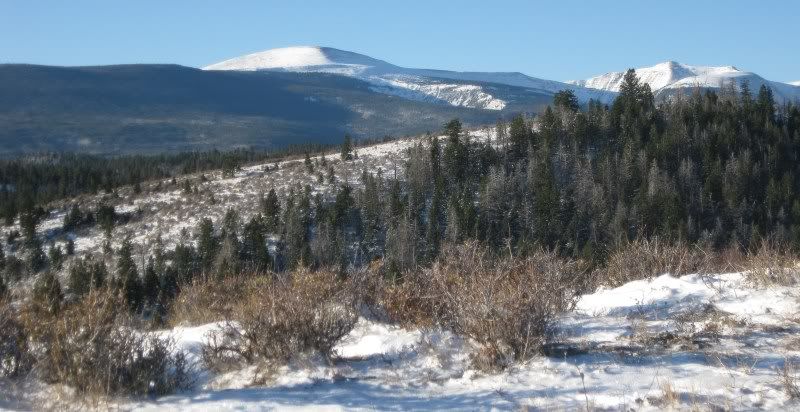
I fell once on an old beaver dam, catching myself with the toe of the buttstock. I fell again in some rocks and the butt hit a rock and split the toe of the stock off. I can repair this, but probably won't get it done for the rest of this season. So I carried my .54 Bridger Hawken the next day, and will the rest of this season. We saw only one spike bull killed out of maybe 30 camps we drove past. Not enough snow yet, but I
feel we did our best so far.
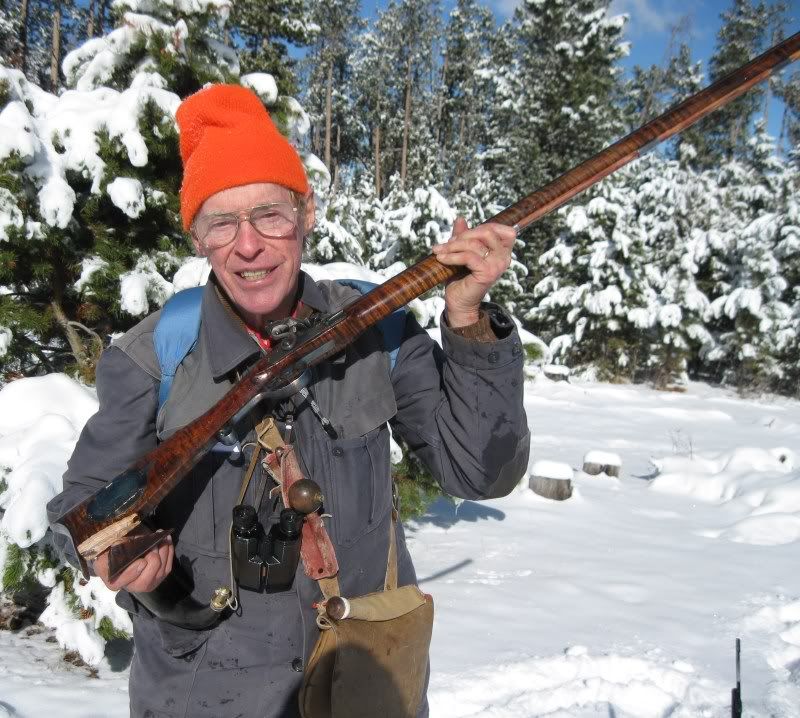

I fell once on an old beaver dam, catching myself with the toe of the buttstock. I fell again in some rocks and the butt hit a rock and split the toe of the stock off. I can repair this, but probably won't get it done for the rest of this season. So I carried my .54 Bridger Hawken the next day, and will the rest of this season. We saw only one spike bull killed out of maybe 30 camps we drove past. Not enough snow yet, but I
feel we did our best so far.

hoochiepapa
75 Cal.
- Joined
- Oct 25, 2010
- Messages
- 5,853
- Reaction score
- 7
Sorry about your rifle, Herb!!
THe hunting will turn into finding soon I hope!
I did the same thing when I was 16 with my dad's Mannlicher. I rolled a rock, and used the butt of the gun to catch myself. My dad was more angry about his rifle that he was relieved of my safety.
THe hunting will turn into finding soon I hope!
I did the same thing when I was 16 with my dad's Mannlicher. I rolled a rock, and used the butt of the gun to catch myself. My dad was more angry about his rifle that he was relieved of my safety.
hanshi
Cannon
Yeah, busting a rifle would make me sick even though I'd know it could be repaired.
- Joined
- Feb 12, 2008
- Messages
- 429
- Reaction score
- 395
Herb,
Well, I would say that is too bad about the hunt and rifle...however, you got into some spectacular country and you got a new "beauty mark" on your rifle. Not the best, but dog-gone-it! you had some fun and got to go hunting. Not a bad way to spend some a few pages of your life story.
p.s. the last time I used my .257bob on an elk hunt it came home snapped at the wrist...stupid fat-assed mare!
Well, I would say that is too bad about the hunt and rifle...however, you got into some spectacular country and you got a new "beauty mark" on your rifle. Not the best, but dog-gone-it! you had some fun and got to go hunting. Not a bad way to spend some a few pages of your life story.
p.s. the last time I used my .257bob on an elk hunt it came home snapped at the wrist...stupid fat-assed mare!
Herb
54 Cal.
- Joined
- Mar 19, 2004
- Messages
- 1,954
- Reaction score
- 456
Fixed my rifle so if I find a bull elk tomorrow, hunting alone, and get a shot, it will be with a flintlock.
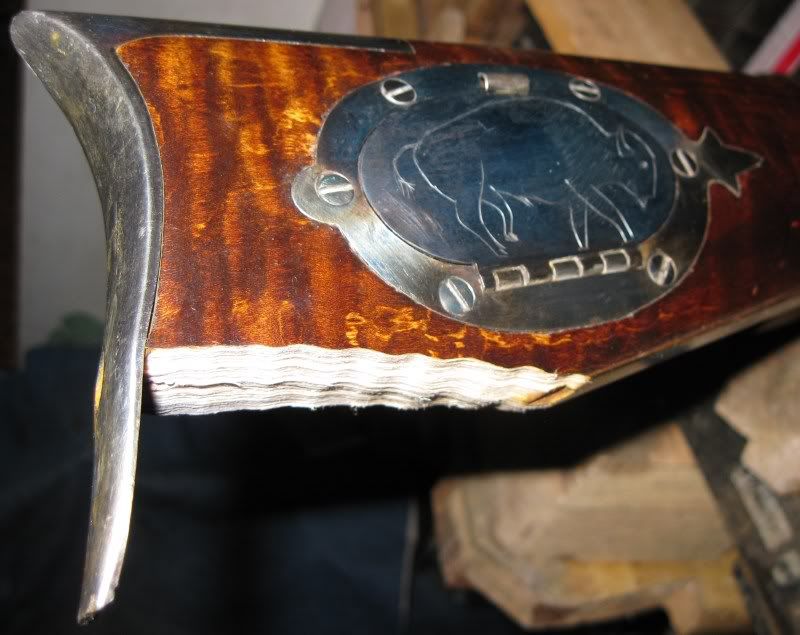
I had used 1/4" long screws to hold the toeplate, why I don't know, never used those little things before. The plate skidded forward and chipped out.
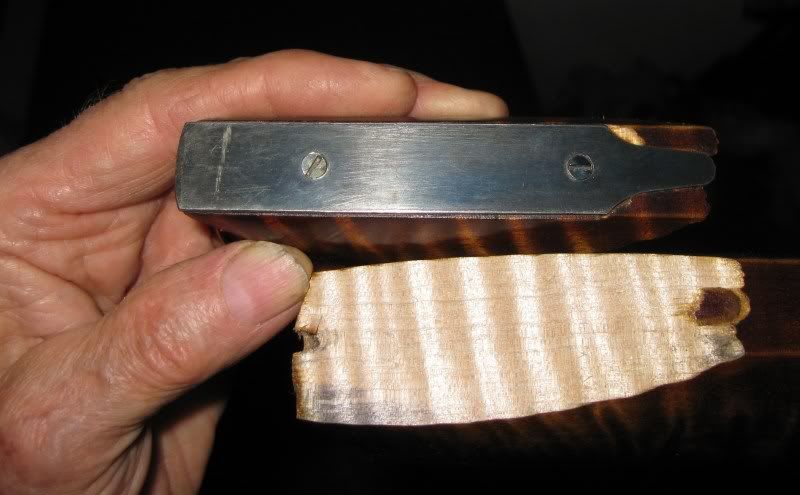
I wet both surfaces with Titebond II glue and cinched up the vise. Got a good match at the end but should have fitted the sides better.
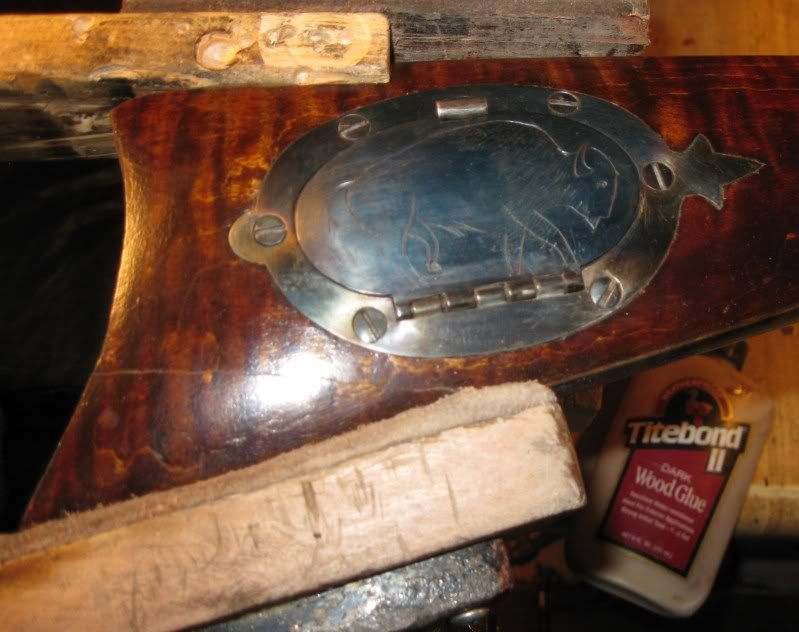
Had to pound the buttplate back to shape as near as I could. Used a 3/4" long rear screw in the toeplate and an inch long screw in the front hole. Under it in between I put in a 2" long screw to reinforce the toe. Will touch up the glue line after I'm done hunting and maybe I can fit the toe of the buttplate better.
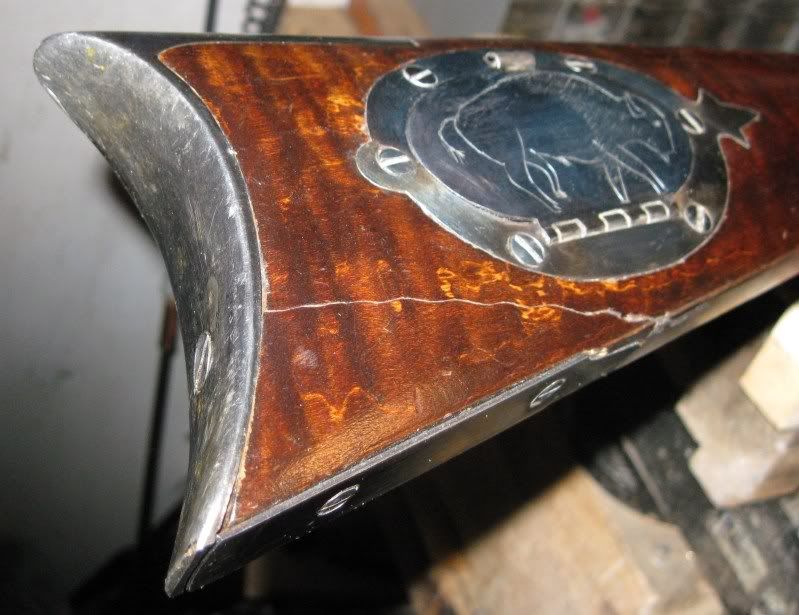

I had used 1/4" long screws to hold the toeplate, why I don't know, never used those little things before. The plate skidded forward and chipped out.

I wet both surfaces with Titebond II glue and cinched up the vise. Got a good match at the end but should have fitted the sides better.

Had to pound the buttplate back to shape as near as I could. Used a 3/4" long rear screw in the toeplate and an inch long screw in the front hole. Under it in between I put in a 2" long screw to reinforce the toe. Will touch up the glue line after I'm done hunting and maybe I can fit the toe of the buttplate better.

hoochiepapa
75 Cal.
- Joined
- Oct 25, 2010
- Messages
- 5,853
- Reaction score
- 7
I hope you get a nice bull, Herb!!
Similar threads
- Replies
- 3
- Views
- 276



